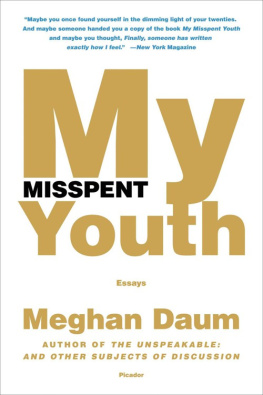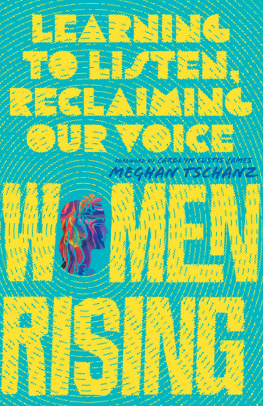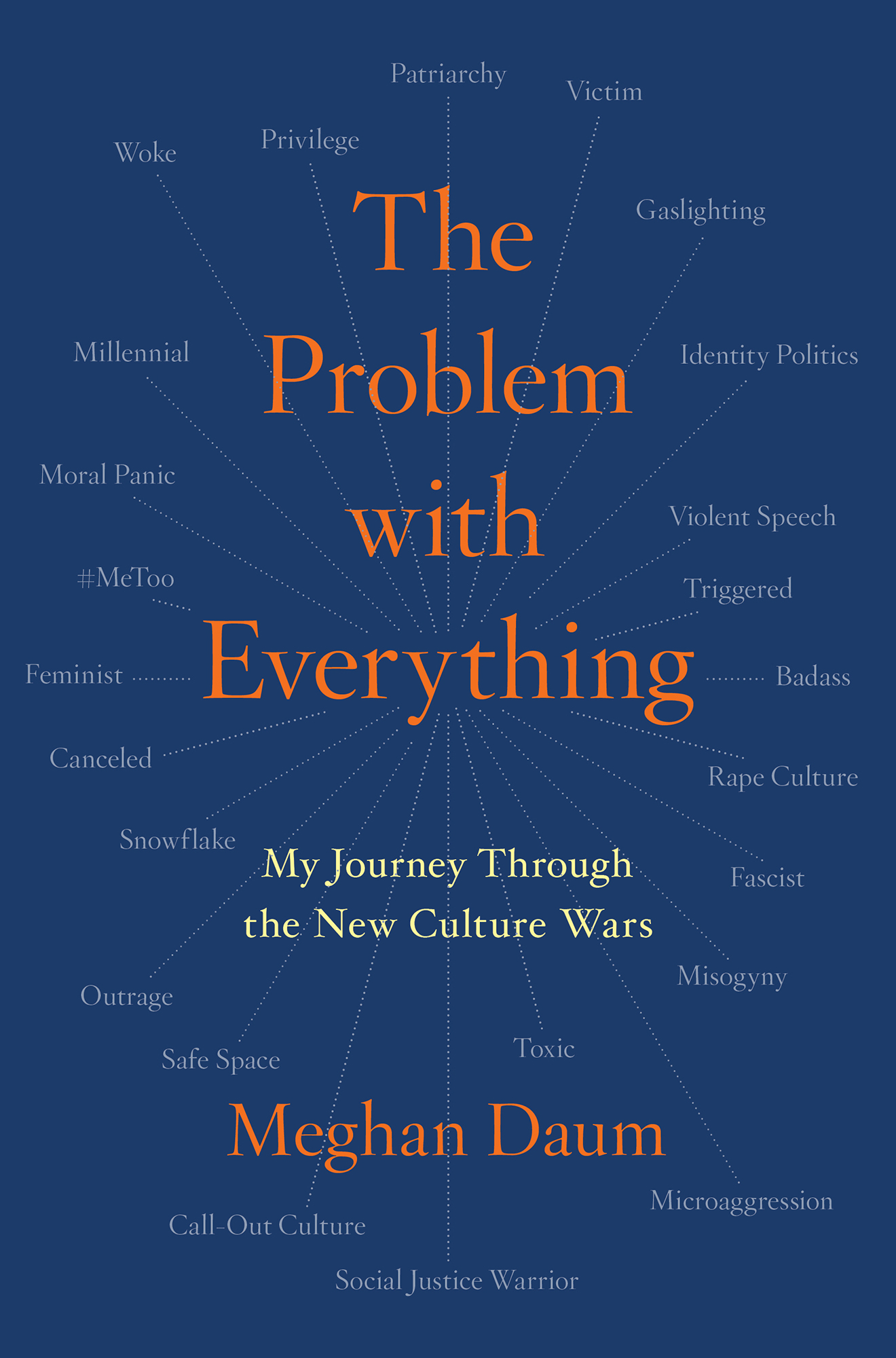Contents
Guide

Gallery Books
An Imprint of Simon & Schuster, Inc.
1230 Avenue of the Americas
New York, NY 10020
www.SimonandSchuster.com
Copyright 2019 by Meghan Daum
All rights reserved, including the right to reproduce this book or portions thereof in any form whatsoever. For information, address Gallery Books Subsidiary Rights Department, 1230 Avenue of the Americas, New York, NY 10020.
First Gallery Books hardcover edition October 2019
GALLERY BOOKS and colophon are registered trademarks of Simon & Schuster, Inc.
For information about special discounts for bulk purchases, please contact Simon & Schuster Special Sales at 1-866-506-1949 or .
The Simon & Schuster Speakers Bureau can bring authors to your live event. For more information or to book an event, contact the Simon & Schuster Speakers Bureau at 1-866-248-3049 or visit our website at www.simonspeakers.com.
Jacket design by Jason Gabbert
Author photo by Nina Subin
Library of Congress Cataloging-in-Publication Data is available.
ISBN 978-1-9821-2933-0
ISBN 978-1-9821-2935-4 (ebook)
Dedicated to the memory of my father, the original critical thinker
The half-truths, repeated, authenticated themselves.
Joan Didion, The Womens Movement, 1972
Introduction
T his began as a book about feminism and only feminism.
I started in the fall of 2016, on the cusp of what would obviously be Hillary Clintons election to the presidency. The book was a critique of the current state of the womens movement. It wasnt going to make every feminist happy, but we were about to have a female president, so I figured they could handle it.
My criticisms were centered on what are sometimes referred to as the excesses of contemporary feminism. I was tired of what I saw as the movements lack of shading and dimension. I was tired of the one-note outrage, the snarky memes, the exhibitionism, the ironic misandry in the vein of #KillAllMen, the commodification of the concept of giving zero fucks (the number of T-shirts for sale on Etsy displaying some iteration of DGAF, or dont give a fuck, amounts to a genuine fuckton). I supported the fundamentals of the message, of course; women deserve equal status to men and should have autonomy over their bodies (at least these were the fundamentals as I saw them). But I was wary that the blustering tone of the media, social media especially, had set up an overcorrection that was veering into self-parody.
Feminism had achieved many of its goals, the passage of laws around equal pay and reproductive rights, the ability of wives to initiate divorce, and access to education for women, to name a few. There was more work to be done, of course. Which is why I was so worried that feminism was in danger, especially on the social media front, of becoming a noisepooland from there an echo chamberof manufactured or at least highly exaggerated problems. And these werent problems as we usually think of them but, rather, everyday phenomena now reclassified as problematic. Some of this problematica (my word) grew out of the sudden problematization (their word, alas) of masculinity. Men, with their unchecked power and privilege, were purveyors of intolerable scourges like mansplaining and manspreading. In fact, so unassailable was their power that women who bashed them could do no damage because these women were effectively punching up to unassailable male power. Articles like Bustles 6 Reasons Men Can Literally Never Be Victims of Sexism, Jezebels Men (Wrongly) Think Theyre Smarter Than They Are (that one dates back to 2008), and Everyday Feminisms 160+ Examples of Male Privilege in All Areas of Life were emblematic of that mentalityand endemic in the feminist blogosphere.
On its face, most of this stuff was too silly to get all that exercised about. We know by now that a lot of whats on the internet is much ado about nothing. But what bothered me most about this new feminism was something more generalsomething ambient, really. What bothered me was the way the prototypical young feminist had adopted the sort of swaggering, wise-ass persona you see most often in people who deep down might not be all that swaggering or wise. This young feminist frequently referred to herself as a badass.
Originally, this book was going to be called You Are Not a Badass. Then Hillary Clinton lost the election to Donald Trump. Along the way, much of the country lost its appetite for the sort of critique I was offering. There is no doubt that had Clinton won, a special kind of pernicious and ugly sexism would have underscored her presidency. The badass feminists would still have had their hands full calling out all the sexist barbssubtle and otherwiseaimed in Clintons direction. But the way things turned out, there was no subtlety to be found. There was no room for left-on-left critique of any variety.
The word tribal was suddenly everywhere. It now referred not to ethnic ties dating back thousands of years but to more recently established affiliations of class and culture. According to the pundits, it was tribalism that had formed those information silos that kept us from seeing this coming. It was tribalism that had caused so many people to pull the lever for someone they found morally reprehensible yet somehow less threatening than the alternative. And though feminism occupied a large space in this expanding conversation about identity and American values, there was clearly now much more to talk about than silly memes and shallow expressions of badassedness (or, to use my preferred construction, badassery).
The country was falling apart. I now realize I was falling apart, tooat least a bit.
As with the country, my meltdown was already in progress by the fall of 2016, but up until then Id been only partially aware of the extent of it. I knew I was experiencing some stress from (to borrow a term from insurance companies) a qualifying life event, namely divorce. I knew Id probably added to that stress by moving across the country by myself with no steady work and a Saint Bernard (the move was an effort to make a clean break from my marriage, since the marriage had never been quite bad enough to break cleanly on its own). What I did not fully comprehend were the ways in which my unrest ran deeper than divorce and relocation.
I was suddenly obsessed with agingmy own as well as that of others. I had up until then lived a life of precociousness, having mostly older friends and often being the youngest person in any given room. Now, though, my joints were literally and figuratively beginning to creak. I was hearing voices inside my head yelling the equivalent of get off my lawn. I supported social justice causes as much as the next self-respecting liberal, yet I was irritated by the smug vibe of many young activists within the new left. This vibe was especially observable in the ones who had embraced the concept of being woke, a term borrowed from the black civil rights movement that signaled ones allegiance to a more general ethos of progressive righteousness. (In the spirit of all of this, I coined my own term to describe the class of NPR-listening, New Yorkerreading, Slate-podcast-downloading elites once called the cognoscenti. They were now the wokescenti.)
Meanwhile, the pace at which the digital revolution was moving had me feeling old before my time, even physically dizzy on a near-daily basis. At my computer, the tweets and memes and hot takes scrolled down my screen so fast I could scarcely comprehend a fraction of them. Whereas my life had once felt like a road trip on which I was usually running ahead of schedule, I now felt like I was running on a treadmill, the mat churning beneath me at high speed while I held on to the handlebars for dear life. I wanted to slow the machine down so I could catch my breath. Sometimes I even thought it might be nice to go to sleep for five or ten years, until this madness somehow ran its course. The phrase woke me when its over became a little in-joke with myself.












